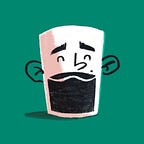The best design tool of 2020 is not what you expect
For a while, I’ve been thinking about design tools and how much the design community becomes obsessed with them, myself included, of course. And because it’s that time of the year, I decided to write about it, more specifically, pick what I think is the best design tool. Spoiler alert, it’s not what you expect.
Many contenders…
When I first experienced design software I was astounded. A new world of opportunities had just opened in front of my eyes.
I couldn’t believe what was possible thanks to the magic of technology and tools like Photoshop, Corel Draw, and my personal favourites, at the time, Macromedia Freehand and Flash
17 years later I’m even more amazed, computers and digital tools have evolved to incredible levels, enabling creatives not just to put their ideas into practice faster, but also to make things that wouldn’t be possible otherwise.
And the best part of it all is that we can only go up from here, tools will get even better, faster, and more accessible.
Now when I try to think about which one is best, my mind runs through a bunch of candidates like Adobe Creative Cloud, and their wide range of amazing tools, recently made even better by leveraging some of the iPad native capabilities.
Speaking of the iPad, Procreate along with many other drawing and animation apps have made digital drawing and animation so much easier, and enjoyable.
Figma and Sketch continue helping design teams across the world become faster and more efficient.
Framer, Principle, Origami and so many others help designers transform their designs into high fidelity interactive prototypes that allow them to test and validate their ideas.
Tools like Webflow empower designers to create not just a prototype but actually deliver a final product.
And let’s not forget things like Icons8, Unsplash, Blush and so many other useful libraries that help designers to pull together high-fidelity solutions faster than ever, or the uncountable amount of websites you can get mock-up templates from, that help designer get a feel to what their ideas would look like in the real world.
Lastly the classics, pen and paper, and any other equivalent, because for ages they’ve been crucial tools of ideation, sketching, and low fidelity design, and I think they will always be.
So… a lot of contenders. So many, that you may be thinking it’s impossible to just pick one, but actually it isn’t.
The winner
It’s pretty obvious what’s the best tool we have at our disposal, that just happens to be behind all the tools mentioned above, and more.
The best design tool is *drum rolls* by far *more drum rolls* your brain.
your brain.
It’s the thing that helps you move forward, come up with ideas, ask the right questions, and make decisions.
It even works autonomously sometimes. How? Have you ever been taking a shower or doing something mundane and suddenly an idea pops in your head, out of nowhere? How amazing is that?
Have you heard of “flow state” or “being in the zone”? That moment when you’re making progress in a way that almost feels effortless, what do you think powers that state? Your brain!
The coolest thing is that it’s the most accessible tool around, everyone has it and it doesn’t even require an internet connection. And as other tools continue to evolve and our work is more efficient, you’ll just end up using your brain more and more.
Ok… the brain is a clear winner, but…
What am I really trying to say?
Tools will change, some will become obsolete, new ones will pop up. The thing that won’t change is your brain, so it’s key to remember to take care of it.
Rather than investing all your resources in mastering tools that will eventually fade out with time, consider using some of your resources to cultivate your brain.
Don’t get me wrong, I’m far from trying to discourage you to take full advantage of the tools we have available today. I’m just trying to stress that there’s way more to design than execution, the most significant progress happens in your mind.
Thus I encourage you to prioritize the thing you use more often and will always be there.
The good news is that learning the tools is good stimulation for your mind, but it’s not enough.
It’s incredibly important to invest time in reflecting on the work you’ve done, look for opportunities to improve, and take that as a lesson moving forwards.
If I look back at my work and I don’t see anything I would do differently, that just tells me that I’ve stopped growing.
We can all reach higher if we stand on someone else’s shoulders, especially if that someone is a giant.
Beyond that, and I would even say, more importantly, learn from others.
Whether that’s by reading a book or an article, watching a documentary or short video or even just browsing a case study. Anything that can give you access to work and lessons learnt from others is an essential resource for your brain.
Thanks for reading! Since you made it this far, I’ll introduce myself.
My name is José Torre, I’m a designer and I write stuff here sometimes.
If you feel like talking, connecting or just want to see what I’m up to, I’m Halfool on Youtube and Instagram, and you can also follow me on Twitter and LinkedIn.
